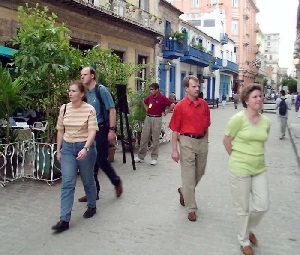 The 36th edition of Cuba’s International Tourism Fair, FITCuba 2016, saw the highest number of participants ever, with representatives from more than 50 countries, together with those attending the 60th World Tourism Organization (UNWTO) Regional Commission for the Americas, which was also held in Havana.
The 36th edition of Cuba’s International Tourism Fair, FITCuba 2016, saw the highest number of participants ever, with representatives from more than 50 countries, together with those attending the 60th World Tourism Organization (UNWTO) Regional Commission for the Americas, which was also held in Havana.
Havana itself is particularly recognized as a tourist destination during FITCuba. Cuban Tourism Minister Manuel Marrero described the capital as a beautiful city, that distinguishes Cuba from the rest of the world, reflecting a fusion of races, customs, rich heritage, culture and history.
During his opening remarks, Marrero noted the arrival of 3,524,779 international visitors to the island in 2015, representing growth of 17%, as well as a 13% increase in the number of tourists staying in facilities affiliated with the Ministry of Tourism.
Havana welcomed over 1.6 million tourists in 2015 and thus far this year has seen 572,000 visitors.
Meanwhile, in 2015, “All Cuban territories and tourist destinations saw growth and the largest emissary markets to the island were Canada, which brought 1.3 million Canadians, Germany, the U.S., the United Kingdom, France, Italy, Spain, Mexico, Venezuela and Argentina.”
The minister noted that the end of 2015 was marked by significant events, including the opening of new markets through, for example, the inauguration of direct flights between Beijing and Havana, and the increasing arrival of cruise ships, managed mainly by European and Canadian companies.
Marrero highlighted the consolidation and importance of the non-state sector, as a complement to state-run tourism, with 16,000 rooms, over 1,700 private restaurants and 18 non-agricultural cooperatives. “There aren’t two types of tourism in Cuba, but a single one, in which any form of management participates, equally.”
In addition, a wide-ranging feedback system has revealed advances in customer satisfaction levels and confirmed that comprehensive quality in all services is a priority.
Cosmopolitan and hospitable Havana distinguishes Cuba as a tourist destination. Photo: Juvenal Balán
Marrero also reported that work is ongoing in the implementation of strategies to raise standards and accurately classify establishments in the hotel and tourism sector, to consolidate a distinctive Cuban tourist product.
By the end of last year, 44% of visitors to Cuba had travelled to the island more than once, the quality/value relationship was rated at almost 89%, and almost all tourists said they would recommend Cuba to family and friends.
Among the most popular all-inclusive Caribbean resorts are six Cuban hotels: the Royalton Cayo Santa María; the Meliá Cayo Coco; the Paradisus Rio de Oro; the Meliá Buenavista; the Royalton Hicacos Varadero; and the Iberostar Varadero.
Marrero added that Old Havana’s Plaza Vieja and Trinidad’s Plaza Mayor are ranked number two and eight, respectively, on the list of tourist attractions in the Caribbean, while the second best museum in the region, according to travelers, is the National Fine Arts Museum, and the third best beach in the world is Paradisus on Cayo Largo.
Nevertheless, providing quality services is a daily challenge, and according to the minister, there is a great deal of competition in a sector with growing domestic demand, generating difficulties in the confirmation of reservations, above all in four and five star hotels in Havana, and requiring the acceleration of investment projects.
He also noted that sales and promotional work to disseminate the island’s attractions in novel ways is being improved; other markets are being explored; and some 2,500 new rooms are to be opened.
Marrero explained that priorities include not only constructing new hotels, but also restoring and updating existing facilities. He cited President Raúl Castro, head of the country’s Councils of State and Ministers, who commented that every hotel opened is a factory, and that the renovation of emblematic luxury hotels is needed.
In 2015, tourism had a greater impact in other areas of the economy, meaning direct income of more than 2.8 billion dollars, and the confirmation of the sector as the country’s second most important generator of hard currency, Marrero said.
The minister recalled the more than 70 years of uninterrupted diplomatic relations between Cuba and Canada, the country’s principal emissary market since 1998, and noted the reduced number of tourists from the northern nation, since the Canadian dollar was devalued. Some 1.2 million visited in 2015.
For his part, Canada’s minister of Tourism noted that ties between the two countries are mutually advantageous.
Trinidad’s Plaza Mayor is ranked number eight on the list of tourist attractions in the Caribbean. Photo: Vicente Brito
The 60th meeting of the World Tourism Organization’s Commission for the Americas, also being held during the Fair, addressed issues of broad interest focused on culture.
Ministers of Tourism from throughout the region unanimously approved a joint statement of support and solidarity with the Ecuadoran people, in the wake of a devastating earthquake which left hundreds dead and caused major economic damage.
(Granma)